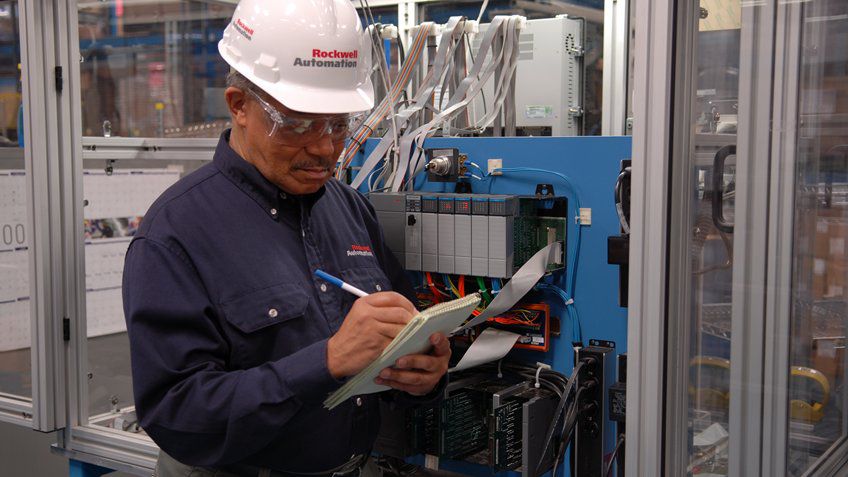Recommended For You
Are you interested in improving your company's machine safety program? Whether your operations are based in one country or around the world, deploying an effective safety program that encompasses all of your plants, employees, machinery, standards and production goals is a substantial undertaking.
Even the most comprehensive safety program can experience head-scratching inconsistencies from plant to plant. Maybe one of your plants is consistently a top safety performer, but another is plagued with ongoing incidents. Perhaps your safety performance is strong across the board, but there are wild variations in safety-related machinery downtime.
One of the biggest challenges, particularly if you are a global manufacturer, is the dispersed nature of your operations. You may be responsible for hundreds or thousands of machines and equipment in plants spread out across multiple regions. You may also be dealing with dated manufacturing applications that don't use the latest safety technologies.
The risks of these inconsistencies and outdated approaches extend beyond worker safety. Safety-related events hurt productivity and threaten the bottom line. Your safety program must be designed around not only how to keep workers safe, but also how to enhance productivity.
New standards and advances in safety technologies are enablers for improving safety and productivity, but an effective safety program requires far more than technology add-ons. It requires a systematic approach that begins with a thorough evaluation of your current safety performance and guides you through a step-by-step journey that impacts every plant, every machine and every employee.
Five key steps are critical to evaluating, developing and implementing an effective, holistic safety program:
Step One: Evaluate Safety Maturity – Begin by forming a cross-functional team to comprehensively measure your current performance. At a minimum, this team should include engineering and environmental health and safety (EHS) representatives who will need to make sure their goals are in concert, rather than competition, with each other.
The team should evaluate the three categories that are integral to effective safety: culture (behavior of your company and workers), compliance (formal procedures and processes) and capital (investments in technology). Assessment tools, such as the Safety Maturity Index™ tool, can help the team evaluate your company's performance in these core areas and provide measurements to see where you succeed and what can still be optimized.
Step Two: Develop a Holistic Safety Strategy – It is important that your team outlines the scope of the safety program. Key considerations here include whether the program will span one country or the entire globe; the number of plants and/or divisions it will encompass; the current safety performance of those plants; whether or not it will include any acquired plants or businesses; the timing of the program; the responsibilities of the personnel involved; the results you intend to achieve; and any documentation requirements.
As part of this step, you will want to develop a comprehensive inventory of machinery to help identify what machines exist at which locations and categorize each machine according to its risk of serious injury and frequency of exposure to a hazard.
You also will need to determine which standards best meet your needs. Whenever possible, work toward the most stringent and encompassing international safety standards, such as ISO 13849 and IEC 62061. These standards can allow for more flexibility in safety system design and help ensure your machinery meets regional requirements no matter where a plant is located.
Step Three: Establish Compliance and Assessment Methodologies – Next you should evaluate the conformity of your existing machinery against the appropriate standards and address noncompliance. Before deciding on your risk-assessment approach, some key considerations include what kind of reports you will need to generate and how you want to document initial and residual risk ratings. Assessment methods can range from a more basic hazard assessment to an in-depth, team-based risk assessment.
Step Four: Develop a Mitigation and Implementation Plan – To develop the plan, start by outlining your functional specs. Evaluate all human-machine interactions and how machinery needs to function in every mode of operation – including normal operation, maintenance, setup and safety-related downtime events.
Next, determine acceptable risk. Safety standards provide several methods of risk reduction, but not every method is acceptable for every manufacturer. A tiered approach (or hierarchy) to risk reduction is often an effective way to determine which method(s) is appropriate. Your safety program should clearly establish the specific mitigation methods that are acceptable.
Finally, determine your design specs, including hardware and safety circuit levels. You will also need to build your standardized parts list and specify how your safeguards are to be installed to prevent incorrect installations that could lead to an incident.
Step Five: Verify, Validate and Maintain the Program – The final step includes verifying that your safety system is properly set up and meets specified performance-level requirements, and validating that the safety circuit works correctly.
In summary, implementing a safety program that accounts for each of these considerations can be a major accomplishment, but implementation itself is not an end. Safety is a constant journey and should be approached with a goal of constant improvement. Particularly as safety technologies and standards evolve, your safety program can flourish and thrive in new ways if you are committed to its improvement.
Published July 1, 2015


